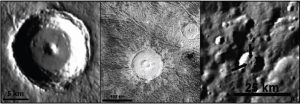
Modified from Figures 2c, 4, and 5c of Barlow et al. (2017)
Throughout the semester the BRIGHT group has been discussing a range of topics. These discussions have included story telling in science communication (Phillips, 2010) and the scientific process as an outline for individual science investigations (and articles) and as a community effort built over multiple investigations. This week, Samantha Peel led the BRIGHT group meeting in a discussion of these concepts as they apply to a recent article by Barlow et al., “Comparison of central pit craters on Mars, Mercury, Ganymede, and the Saturnian Satellites” (2017). This paper discusses early results on a Solar System wide study of central pit craters.
Central pit craters are complex craters that contain centrally located, approximately circular depressions on the crater floor or central uplift. First discussed in the seventies on the Moon (e.g., Allen, 1975; Schultz, 1976), examples of these features have been found on an ever increasing number of solid bodies in the Solar System. Numerous formation mechanism for these features have been proposed based on early observations of central pits on the Moon, Mars, Ganymede and Callisto. Some of these formation mechanism call upon a volatile dependent process, while others do not. This paper is very intriguing, because it inspects central pits between numerous volatile-rich and volatile poor bodies, which can constrain whether central pits on these bodies are formed by the same processes.
The general consensus of the BRIGHT group was that the topic of the research fits within a genesis plot in scientific communication following the definition according to Phillips (2012): “The key research question involves the creation or origin of a specific feature, or a specific type or class of features.” The group also found that the paper follows the scientific method internally, while also highlighting the scientific method as a community process between papers, reporting the first results of a larger Solar System wide investigation.